|
Our Mini Cruise from Falmouth to Pemaquid--August 8-12, 2001
Day 1--August 8, 2001
I loaded the boat in the morning while my wife was at
work. I loaded 60 lb. of ice into the icebox--40 lb. of block, and 2 bags
of cubes for drinks. With this much ice, I could just fit in our fresh
food for the 4-day trip. Admittedly, this was overkill on the ice, but it
was nice to know we wouldn't have to worry about it melting too quickly.
After all, the forecast was for temperatures well into the 90's, at least for a
couple days. Amazingly, I incorporated all the junk we planned to take
into the storage lockers on board. As usual, we overpacked. I added
about 8 gallons of diesel to the unknown quantity already in the tank.
We got aboard late in the day, preparing to spend the night
either on the mooring or at a nearby island. That morning, I had noticed
that the QE2 was in Portland harbor, and had been tempted to motor down then to
have a look, but didn't. We missed it last year because Glissando
was still on the hard in our backyard at the time. Therefore, we decided
to motor down the 5-6 miles to Portland and have a look. It was a pleasant
evening.
Well, we had barely gotten halfway to Portland when Heidi,
sort of off-handedly, said "Did the ship just move?" I said,
"Don't even say that!" But she was right--there was a
tugboat at her bow, and, sure enough, she must have just weighed anchor.
Movement was slow at first, but it became rapidly apparent that we weren't going
to get there in time--we were still about 2 miles out. Then, just like
that, the huge liner disappeared behind the islands in the ship channel, and was
gone. We turned around, and unrolled the jib for what turned out to be a
thrilling 1-1.5-knot sail back. After a while, we turned the engine back
on. I had some questions about whether the engine was charging the
batteries or not, and had taken the time earlier to print out some
troubleshooting guides from the Ample Power website. I planned to work on
this a little during the cruise.
Day 2--August 9, 2001
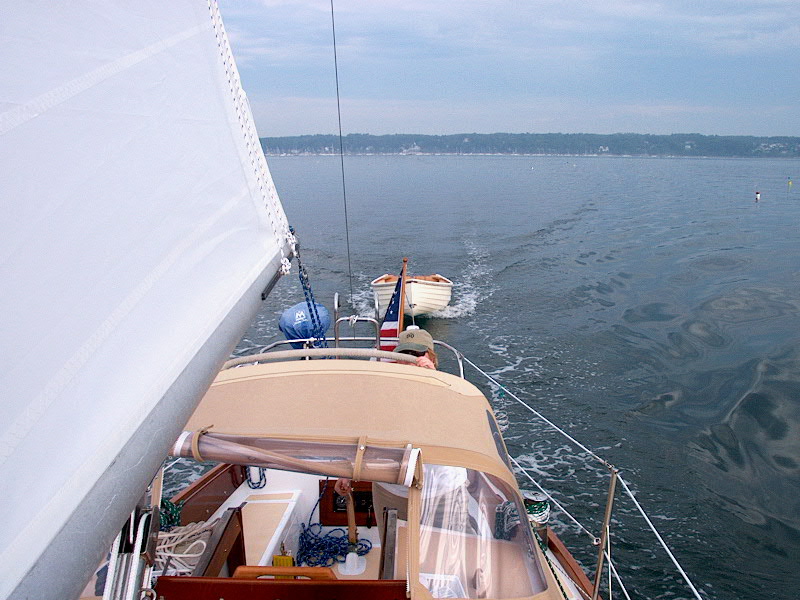 The
day dawned (sort of) glassy calm and mostly cloudy, with a strange filtered
light. By 0730, it still seemed so dim out that it was more like
0530. Odd. The weather was warm and humid, and they were predicting
temperatures as high as 100° during the day. Unfortunately, they were
also warning of a string of severe thunderstorms that might come through during
the morning. I was a little worried about the forecast, but figured I'd
keep a weather eye out and be prepared for any eventuality. We raised the
main--I like to always raise the main when setting out on a longer passage under
power, for a couple reasons: it helps steady the boat in a seaway, and it
makes it easier to get under sail later on if the wind comes up. At 0751,
we were underway. Our rough target for the day was Five Islands, in the
Sheepscot River east of Cape Small. Cruising speed at 2650 RPM was 5.25
knots. I activated my pre-programmed route on the GPS, and away we went. The
day dawned (sort of) glassy calm and mostly cloudy, with a strange filtered
light. By 0730, it still seemed so dim out that it was more like
0530. Odd. The weather was warm and humid, and they were predicting
temperatures as high as 100° during the day. Unfortunately, they were
also warning of a string of severe thunderstorms that might come through during
the morning. I was a little worried about the forecast, but figured I'd
keep a weather eye out and be prepared for any eventuality. We raised the
main--I like to always raise the main when setting out on a longer passage under
power, for a couple reasons: it helps steady the boat in a seaway, and it
makes it easier to get under sail later on if the wind comes up. At 0751,
we were underway. Our rough target for the day was Five Islands, in the
Sheepscot River east of Cape Small. Cruising speed at 2650 RPM was 5.25
knots. I activated my pre-programmed route on the GPS, and away we went.
The trip was generally uneventful. At one point, about
45 minutes after departure, it looked like we might get hit with a boomer--the
sky to the northwest was dark and foreboding. However, shortly thereafter
the sun finally broke free of the odd low cloud bank surrounding the horizon,
and the dark quality of the clouds disappeared. The wind remained
nonexistent, and we powered outside of Quahog Bay and the New Meadows River with
a gentle swell on the beam.
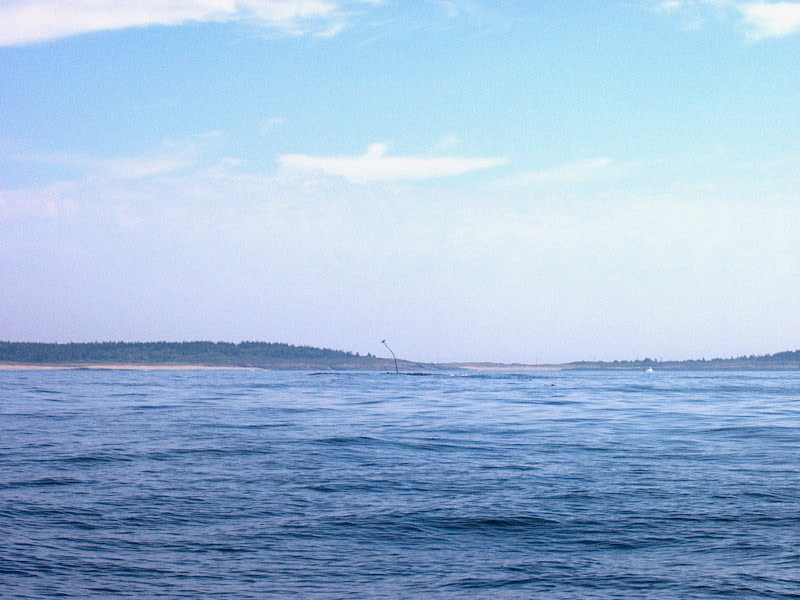 At
0947, we passed by Bald Head Ledge, off Cape Small. This is a nasty ledge,
although easy enough to avoid. What makes it particularly scary looking is
the odd daymarker installed on the rock. For as long as I can remember,
the marker has been bent and twisted, giving it a particularly evil
appearance. Even the moderate swells on this flat day boiled and churned
over the ledge. There's what looks similar to a wagon wheel on top of the
marker, with the standard Osprey's nest haphazardly hanging off at an angle. At
0947, we passed by Bald Head Ledge, off Cape Small. This is a nasty ledge,
although easy enough to avoid. What makes it particularly scary looking is
the odd daymarker installed on the rock. For as long as I can remember,
the marker has been bent and twisted, giving it a particularly evil
appearance. Even the moderate swells on this flat day boiled and churned
over the ledge. There's what looks similar to a wagon wheel on top of the
marker, with the standard Osprey's nest haphazardly hanging off at an angle.
 Shortly
thereafter, we passed by Cape Small, with its little observation tower at the
end. I'm not sure what this was, or is, used for--better brush up on
my local history, I guess. Shortly
thereafter, we passed by Cape Small, with its little observation tower at the
end. I'm not sure what this was, or is, used for--better brush up on
my local history, I guess.
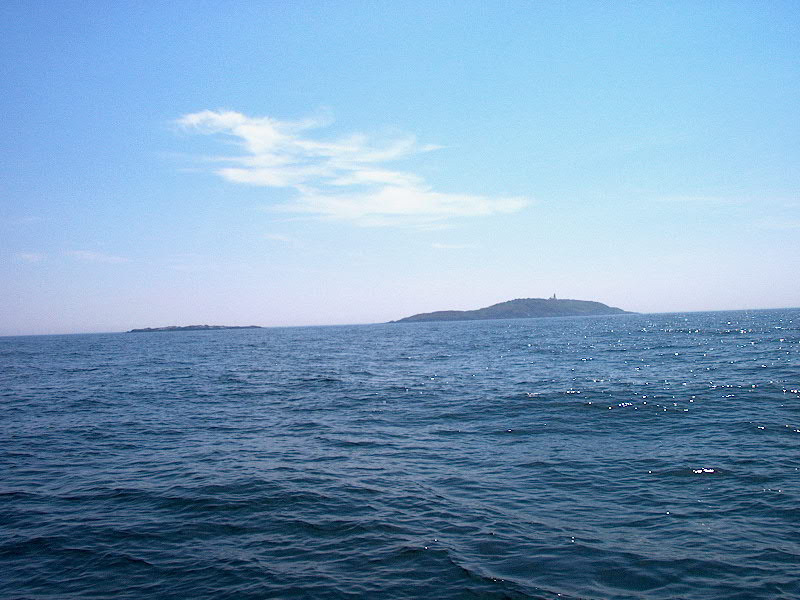 After
passing between Cape Small and Fuller Rock, we changed course for the Sheepscot
River. The passage brought us inside of Sequin Island--a high, Irish-moor
looking island with one of the few remaining Fresnel lenses in the lonely lighthouse.
Nearby to the north (left) is Ellingwood rock--my wife's maiden name. After
passing between Cape Small and Fuller Rock, we changed course for the Sheepscot
River. The passage brought us inside of Sequin Island--a high, Irish-moor
looking island with one of the few remaining Fresnel lenses in the lonely lighthouse.
Nearby to the north (left) is Ellingwood rock--my wife's maiden name.
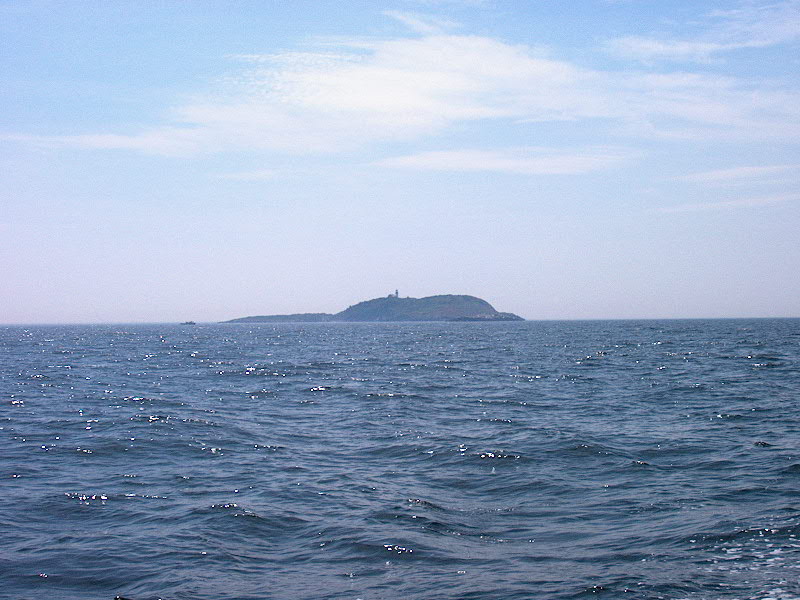
 We
passed by the mouth of the Kennebec river, with its attractive lighthouse
nestled on a small island, and an old wartime fort on the mainland behind, near
one of the last good beaches as you head downeast. We
passed by the mouth of the Kennebec river, with its attractive lighthouse
nestled on a small island, and an old wartime fort on the mainland behind, near
one of the last good beaches as you head downeast.
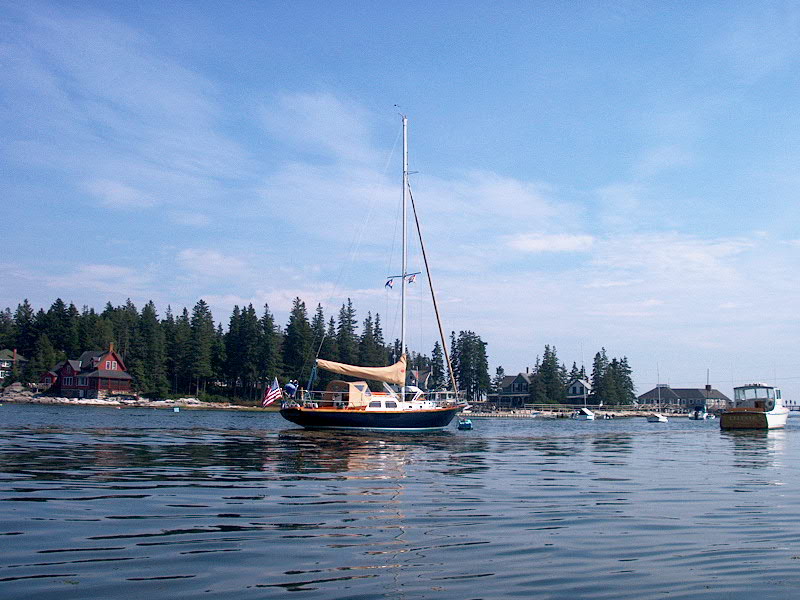 Next,
the wide mouth of the Sheepscot river opened up to the north. Several
miles wide, the mouth is so open that it is actually called Sheepscot Bay.
We had a pleasant trip the few miles up the bay to our destination--Five
Islands. This is a neat little harbor surrounded by, as the name implies,
five bold islands. Space inside is tight, and there's no room to
anchor. However, the so-called Five Islands Yacht Club provides several
free moorings for use--what a refreshing idea! Thanks! By 1315, we
had picked up one of the moorings in the picturesque harbor, and were enjoying
lunch. We spent the afternoon reading, rowing around the harbor checking
out the local scenery, and generally relaxing. A nice seabreeze came up
right as we arrived, which kept the temperatures very comfortable--little did we
know how everyone inland was sweltering in record heat. Next,
the wide mouth of the Sheepscot river opened up to the north. Several
miles wide, the mouth is so open that it is actually called Sheepscot Bay.
We had a pleasant trip the few miles up the bay to our destination--Five
Islands. This is a neat little harbor surrounded by, as the name implies,
five bold islands. Space inside is tight, and there's no room to
anchor. However, the so-called Five Islands Yacht Club provides several
free moorings for use--what a refreshing idea! Thanks! By 1315, we
had picked up one of the moorings in the picturesque harbor, and were enjoying
lunch. We spent the afternoon reading, rowing around the harbor checking
out the local scenery, and generally relaxing. A nice seabreeze came up
right as we arrived, which kept the temperatures very comfortable--little did we
know how everyone inland was sweltering in record heat.
Click here for a few
more pictures of Five Islands.
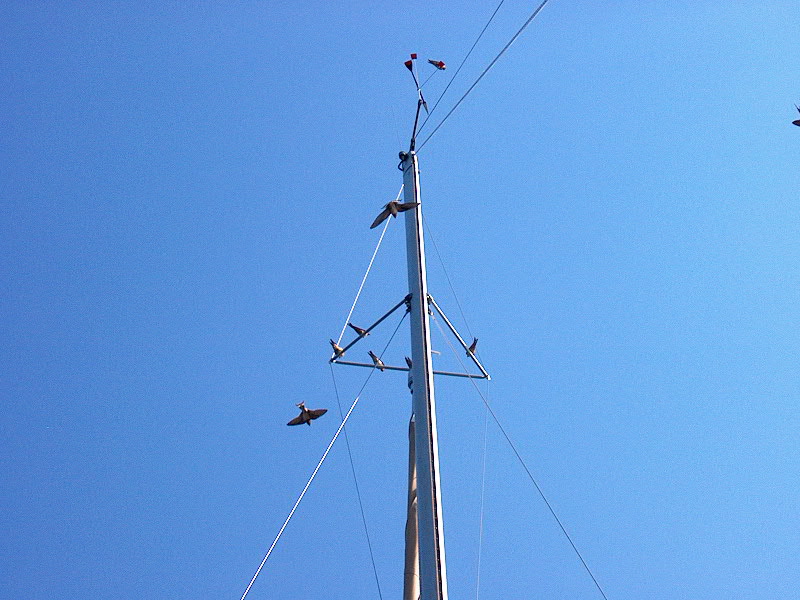 We
had kind of a fun experience during the afternoon. Ever since arrival,
Glissando seemed to be swarmed by resident Swallows in the harbor. We
don't really know why, but they seemed to like the boat. At one point, we
had, I think, 13 of them perched on the jumpers and the nearby masthead!
This photo shows several of them alighted on the jumpers, and a few more in
flight attempting to land. We
had kind of a fun experience during the afternoon. Ever since arrival,
Glissando seemed to be swarmed by resident Swallows in the harbor. We
don't really know why, but they seemed to like the boat. At one point, we
had, I think, 13 of them perched on the jumpers and the nearby masthead!
This photo shows several of them alighted on the jumpers, and a few more in
flight attempting to land.
Please click here
to continue the log.
|

 The
day dawned (sort of) glassy calm and mostly cloudy, with a strange filtered
light. By 0730, it still seemed so dim out that it was more like
0530. Odd. The weather was warm and humid, and they were predicting
temperatures as high as 100° during the day. Unfortunately, they were
also warning of a string of severe thunderstorms that might come through during
the morning. I was a little worried about the forecast, but figured I'd
keep a weather eye out and be prepared for any eventuality. We raised the
main--I like to always raise the main when setting out on a longer passage under
power, for a couple reasons: it helps steady the boat in a seaway, and it
makes it easier to get under sail later on if the wind comes up. At 0751,
we were underway. Our rough target for the day was Five Islands, in the
Sheepscot River east of Cape Small. Cruising speed at 2650 RPM was 5.25
knots. I activated my pre-programmed route on the GPS, and away we went.
The
day dawned (sort of) glassy calm and mostly cloudy, with a strange filtered
light. By 0730, it still seemed so dim out that it was more like
0530. Odd. The weather was warm and humid, and they were predicting
temperatures as high as 100° during the day. Unfortunately, they were
also warning of a string of severe thunderstorms that might come through during
the morning. I was a little worried about the forecast, but figured I'd
keep a weather eye out and be prepared for any eventuality. We raised the
main--I like to always raise the main when setting out on a longer passage under
power, for a couple reasons: it helps steady the boat in a seaway, and it
makes it easier to get under sail later on if the wind comes up. At 0751,
we were underway. Our rough target for the day was Five Islands, in the
Sheepscot River east of Cape Small. Cruising speed at 2650 RPM was 5.25
knots. I activated my pre-programmed route on the GPS, and away we went. At
0947, we passed by Bald Head Ledge, off Cape Small. This is a nasty ledge,
although easy enough to avoid. What makes it particularly scary looking is
the odd daymarker installed on the rock. For as long as I can remember,
the marker has been bent and twisted, giving it a particularly evil
appearance. Even the moderate swells on this flat day boiled and churned
over the ledge. There's what looks similar to a wagon wheel on top of the
marker, with the standard Osprey's nest haphazardly hanging off at an angle.
At
0947, we passed by Bald Head Ledge, off Cape Small. This is a nasty ledge,
although easy enough to avoid. What makes it particularly scary looking is
the odd daymarker installed on the rock. For as long as I can remember,
the marker has been bent and twisted, giving it a particularly evil
appearance. Even the moderate swells on this flat day boiled and churned
over the ledge. There's what looks similar to a wagon wheel on top of the
marker, with the standard Osprey's nest haphazardly hanging off at an angle.
 After
passing between Cape Small and Fuller Rock, we changed course for the Sheepscot
River. The passage brought us inside of Sequin Island--a high, Irish-moor
looking island with one of the few remaining Fresnel lenses in the lonely lighthouse.
Nearby to the north (left) is Ellingwood rock--my wife's maiden name.
After
passing between Cape Small and Fuller Rock, we changed course for the Sheepscot
River. The passage brought us inside of Sequin Island--a high, Irish-moor
looking island with one of the few remaining Fresnel lenses in the lonely lighthouse.
Nearby to the north (left) is Ellingwood rock--my wife's maiden name.

 Next,
the wide mouth of the Sheepscot river opened up to the north. Several
miles wide, the mouth is so open that it is actually called Sheepscot Bay.
We had a pleasant trip the few miles up the bay to our destination--Five
Islands. This is a neat little harbor surrounded by, as the name implies,
five bold islands. Space inside is tight, and there's no room to
anchor. However, the so-called Five Islands Yacht Club provides several
free moorings for use--what a refreshing idea! Thanks! By 1315, we
had picked up one of the moorings in the picturesque harbor, and were enjoying
lunch. We spent the afternoon reading, rowing around the harbor checking
out the local scenery, and generally relaxing. A nice seabreeze came up
right as we arrived, which kept the temperatures very comfortable--little did we
know how everyone inland was sweltering in record heat.
Next,
the wide mouth of the Sheepscot river opened up to the north. Several
miles wide, the mouth is so open that it is actually called Sheepscot Bay.
We had a pleasant trip the few miles up the bay to our destination--Five
Islands. This is a neat little harbor surrounded by, as the name implies,
five bold islands. Space inside is tight, and there's no room to
anchor. However, the so-called Five Islands Yacht Club provides several
free moorings for use--what a refreshing idea! Thanks! By 1315, we
had picked up one of the moorings in the picturesque harbor, and were enjoying
lunch. We spent the afternoon reading, rowing around the harbor checking
out the local scenery, and generally relaxing. A nice seabreeze came up
right as we arrived, which kept the temperatures very comfortable--little did we
know how everyone inland was sweltering in record heat. We
had kind of a fun experience during the afternoon. Ever since arrival,
Glissando seemed to be swarmed by resident Swallows in the harbor. We
don't really know why, but they seemed to like the boat. At one point, we
had, I think, 13 of them perched on the jumpers and the nearby masthead!
This photo shows several of them alighted on the jumpers, and a few more in
flight attempting to land.
We
had kind of a fun experience during the afternoon. Ever since arrival,
Glissando seemed to be swarmed by resident Swallows in the harbor. We
don't really know why, but they seemed to like the boat. At one point, we
had, I think, 13 of them perched on the jumpers and the nearby masthead!
This photo shows several of them alighted on the jumpers, and a few more in
flight attempting to land.